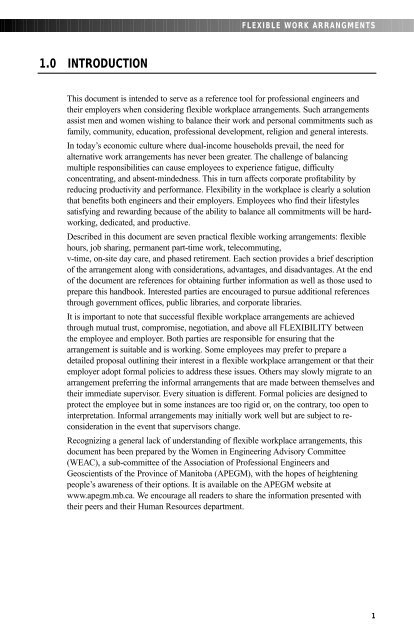FLEXIBLE WORK ARRANGEMENTS - APEGM
FLEXIBLE WORK ARRANGEMENTS - APEGM
FLEXIBLE WORK ARRANGEMENTS - APEGM
Create successful ePaper yourself
Turn your PDF publications into a flip-book with our unique Google optimized e-Paper software.
<strong>FLEXIBLE</strong> <strong>WORK</strong> ARRANGMENTS1.0 INTRODUCTIONThis document is intended to serve as a reference tool for professional engineers andtheir employers when considering flexible workplace arrangements. Such arrangementsassist men and women wishing to balance their work and personal commitments such asfamily, community, education, professional development, religion and general interests.In today’s economic culture where dual-income households prevail, the need foralternative work arrangements has never been greater. The challenge of balancingmultiple responsibilities can cause employees to experience fatigue, difficultyconcentrating, and absent-mindedness. This in turn affects corporate profitability byreducing productivity and performance. Flexibility in the workplace is clearly a solutionthat benefits both engineers and their employers. Employees who find their lifestylessatisfying and rewarding because of the ability to balance all commitments will be hardworking,dedicated, and productive.Described in this document are seven practical flexible working arrangements: flexiblehours, job sharing, permanent part-time work, telecommuting,v-time, on-site day care, and phased retirement. Each section provides a brief descriptionof the arrangement along with considerations, advantages, and disadvantages. At the endof the document are references for obtaining further information as well as those used toprepare this handbook. Interested parties are encouraged to pursue additional referencesthrough government offices, public libraries, and corporate libraries.It is important to note that successful flexible workplace arrangements are achievedthrough mutual trust, compromise, negotiation, and above all FLEXIBILITY betweenthe employee and employer. Both parties are responsible for ensuring that thearrangement is suitable and is working. Some employees may prefer to prepare adetailed proposal outlining their interest in a flexible workplace arrangement or that theiremployer adopt formal policies to address these issues. Others may slowly migrate to anarrangement preferring the informal arrangements that are made between themselves andtheir immediate supervisor. Every situation is different. Formal policies are designed toprotect the employee but in some instances are too rigid or, on the contrary, too open tointerpretation. Informal arrangements may initially work well but are subject to reconsiderationin the event that supervisors change.Recognizing a general lack of understanding of flexible workplace arrangements, thisdocument has been prepared by the Women in Engineering Advisory Committee(WEAC), a sub-committee of the Association of Professional Engineers andGeoscientists of the Province of Manitoba (<strong>APEGM</strong>), with the hopes of heighteningpeople’s awareness of their options. It is available on the <strong>APEGM</strong> website atwww.apegm.mb.ca. We encourage all readers to share the information presented withtheir peers and their Human Resources department.1


